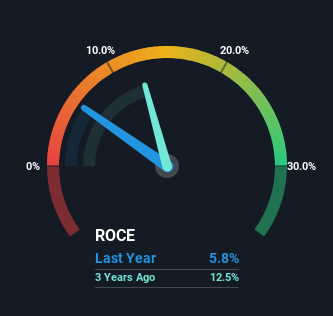If you're not sure where to start when looking for the next multi-bagger, there are a few key trends you should keep an eye out for. Ideally, a business will show two trends; firstly a growing return on capital employed (ROCE) and secondly, an increasing amount of capital employed. This shows us that it's a compounding machine, able to continually reinvest its earnings back into the business and generate higher returns. Having said that, from a first glance at Jones Tech (SZSE:300684) we aren't jumping out of our chairs at how returns are trending, but let's have a deeper look.
What Is Return On Capital Employed (ROCE)?
Just to clarify if you're unsure, ROCE is a metric for evaluating how much pre-tax income (in percentage terms) a company earns on the capital invested in its business. Analysts use this formula to calculate it for Jones Tech:
Return on Capital Employed = Earnings Before Interest and Tax (EBIT) ÷ (Total Assets - Current Liabilities)
 0.058 = CN¥110m ÷ (CN¥2.2b - CN¥357m) (Based on the trailing twelve months to September 2023).
0.058 = CN¥110m ÷ (CN¥2.2b - CN¥357m) (Based on the trailing twelve months to September 2023).
Thus, Jones Tech has an ROCE of 5.8%. In absolute terms, that's a low return but it's around the Electronic industry average of 5.0%.
View our latest analysis for Jones Tech

Historical performance is a great place to start when researching a stock so above you can see the gauge for Jones Tech's ROCE against it's prior returns. If you're interested in investigating Jones Tech's past further, check out this free graph of past earnings, revenue and cash flow.
How Are Returns Trending?
We weren't thrilled with the trend because Jones Tech's ROCE has reduced by 81% over the last five years, while the business employed 191% more capital. That being said, Jones Tech raised some capital prior to their latest results being released, so that could partly explain the increase in capital employed. The funds raised likely haven't been put to work yet so it's worth watching what happens in the future with Jones Tech's earnings and if they change as a result from the capital raise.
On a related note, Jones Tech has decreased its current liabilities to 16% of total assets. So we could link some of this to the decrease in ROCE. Effectively this means their suppliers or short-term creditors are funding less of the business, which reduces some elements of risk. Some would claim this reduces the business' efficiency at generating ROCE since it is now funding more of the operations with its own money.
What We Can Learn From Jones Tech's ROCE
To conclude, we've found that Jones Tech is reinvesting in the business, but returns have been falling. Unsurprisingly then, the total return to shareholders over the last five years has been flat. All in all, the inherent trends aren't typical of multi-baggers, so if that's what you're after, we think you might have more luck elsewhere.
Jones Tech does come with some risks though, we found 4 warning signs in our investment analysis, and 1 of those is potentially serious...
If you want to search for solid companies with great earnings, check out this free list of companies with good balance sheets and impressive returns on equity.
Have feedback on this article? Concerned about the content? Get in touch with us directly. Alternatively, email editorial-team (at) simplywallst.com.
This article by Simply Wall St is general in nature. We provide commentary based on historical data and analyst forecasts only using an unbiased methodology and our articles are not intended to be financial advice. It does not constitute a recommendation to buy or sell any stock, and does not take account of your objectives, or your financial situation. We aim to bring you long-term focused analysis driven by fundamental data. Note that our analysis may not factor in the latest price-sensitive company announcements or qualitative material. Simply Wall St has no position in any stocks mentioned.
